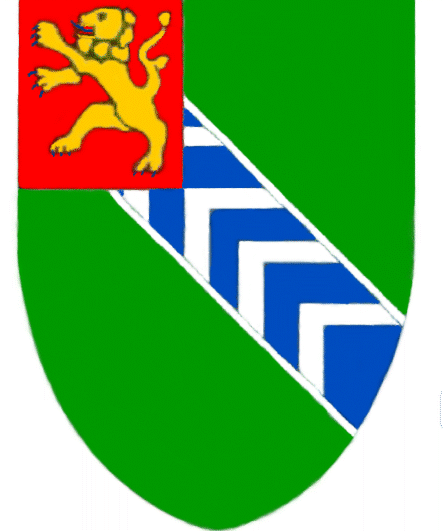

JAN SMUTS HALL, University of Cape Town, Groote Schuur Estate, Cape Town.

The arms may be blazoned:
Vert, a bend chevronny argent and azure, fimbriated argent; overall upon a canton gules a lion rampant or.
These arms were first adopted in 1942, when the hostel was known as Men’s Residence, and have been in use ever since.
The design originated as a jest – hardly surprising when it is recalled that the devising of the house “crest”[1] was opened to the men of the residence for a prize of one guinea![2]
The device originally proposed for a house emblem is a coat of arms that appears at the main entrance. However, the students dropped the idea when they realised that it was the emblem of the Cape of Good Hope (the Cape Colony at the time of the founding of the South African College, and the Cape Province when the Rondebosch campus, including Men’s Res, was erected).
The house website reports: “Very shortly afterwards, Theo le Roux offered a personal reward of one guinea to the man who offered the best accepted design for a crest.”
Regarding the meaning, the website states:
“The Lion rampant represents the same on the wall of the Randall’s Hotel (variously known as Alf’s and the Pig and Whistle), popular and most proximate watering hole for generations of students. The green background is the rugby fields. The broad stripe is the sober path to the aforementioned establishment and the zig-zag lines in University colours anticipate the mood of the retreat to the Residence!”
About the residence:
Two halls of residence, blandly named Men’s Residence and Women’s Residence, were erected on the imposing new campus on the Groote Schuur Estate below Devil’s Peak.[3]
Like the rest of the campus, they were part of a symmetrical layout, focused on the stairs that rose imposingly from the Great Field (now embraced by the expressway called Rhodes Drive) to the Jameson Hall, the centrepiece of the campus.
To the south of the stairs lay Men’s, and matching it on the north side was Women’s (now known as Fuller Hall). Regarding the history and naming of Men’s Res, the house website states:
“The doors of the new residence on the Groote Schuur campus were barely open when there was a call to name it. That was in March 1928. By May, Matopos and New College were put forward as suggestions but they were rejected. A free dance ticket was offered to the person with the most suitable suggestion.
“The following year Nova Tieta, Riebeeck and Matopos were the choices put before the House. An overwhelming majority accepted Matopos, although reservations were expressed about the ‘feeling that might arise out of the name on account of its historical association with Rhodes’.
“Nothing more is mentioned in the minutes of House Committee meetings until the beginning of 1938 when there was again a call for a name. Again the tempting bait was a free dance ticket for the person suggesting ‘the name for the House which is ultimately accepted’.
“There was a lapse until 1941 when several suggestions were made in response to yet another appeal. Entabeni and Ellisona featured on the list. Others were Pensakola (rejected on account of the fact that it sounded too much like ‘pianola’!), Beattie College (after the former Vice-Chancellor, Sir ‘Jock’ Carruthers Beattie) and Burleigh (after Rhodes’s house in England).
“Beattie College was finally voted in by the men but it was turned down by the University on the grounds that there were at the time surviving prominent members on the University Council who were also concerned with the inauguration of Men’s Residence. It was presumed that the matter had been ‘left in abeyance pending the ultimate destiny of the venerable gentlemen concerned’!
“In September 1950, it was brought to the attention of the men of the House at a General House Meeting that there was a move in the direction of giving Women’s Residence a new name and that Men’s Residence might also be involved.
“Fuller Hall ultimately became the new appellation of Women’s Residence but the House Meeting in Men’s Residence that night in September resolved that they would prefer to retain the name under which they had always gone but declared that Smuts Hall[4] would be the most acceptable substitute if the name had to be changed.
“The Warden, J B Clark, passed on the suggestion to the then Principal and Vice-Chancellor, Dr T B Davie. Ouma Smuts,[5] in replying to a letter asking her permission, said that she would be delighted.
“On 10th November 1950, the name Smuts Hall was formally adopted by the House with the following motion at a General House Meeting: ‘That this House endorse the decision of the University Council to change the name of the Residence to “Smuts Hall.” ’ The motion was adopted unanimously.
Afrikaanse blasoen:
Die wapen mag in Afrikaans so geblasoeneer word:
In groen, ’n skuinsbalk gekeper van blou en silwer, en silwer omlyn; oor alles heen ’n vryhoek van rooi waarop ’n klimmende leeu van goud.
